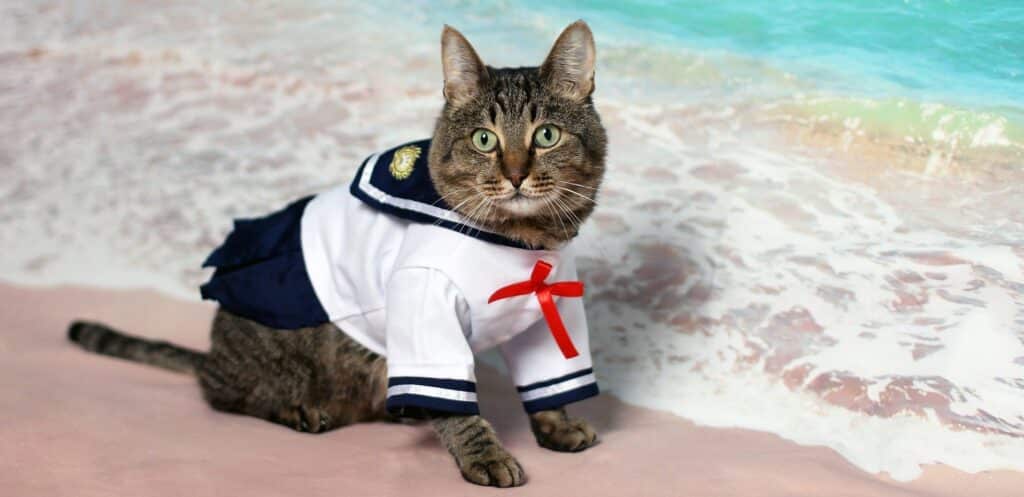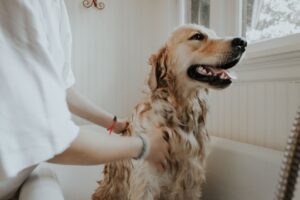



When holidays come around, it might be tempting to give your animal an adorable pair of cupid wings or a Santa hat in preparation for a visit. But before you dust off your pet’s costume collection, take a minute to learn about why it’s best to leave the costumes at home.
 Many handlers are tempted to dress up their therapy animals to add to the magic of the visit, but let’s put ourselves in the client’s shoes. Imagine the novelty of a miniature horse walking down the hall of a hospital, or sitting with a dog who likes listening to you read. These moments in and of themselves are already a remarkable experience! A costume may actually detract from the natural benefits of the human-animal bond. Don’t forget that the real magic on a visit happens because of the connection made between the client and animal at a very deep level. These interventions have meaningful impact that go beyond raising a smile because of a cute outfit.
Many handlers are tempted to dress up their therapy animals to add to the magic of the visit, but let’s put ourselves in the client’s shoes. Imagine the novelty of a miniature horse walking down the hall of a hospital, or sitting with a dog who likes listening to you read. These moments in and of themselves are already a remarkable experience! A costume may actually detract from the natural benefits of the human-animal bond. Don’t forget that the real magic on a visit happens because of the connection made between the client and animal at a very deep level. These interventions have meaningful impact that go beyond raising a smile because of a cute outfit.

While many people think that dressing up an animal is all in good fun, it can be a confusing experience for some clients. Despite your best intentions, if you were to dress your dog up in devil horns for Halloween and visit a person with dementia, the costume could trigger an adverse reaction. If your cat is wearing bunny ears or antlers, some clients may be puzzled about the type of animal they’re visiting with. Therapy animal visits should always be beneficial for those being visited, so any element that could bring confusion or distress should be avoided.
 At Pet Partners, we have very high standards for infection control that may be compromised by costumes. Costume items often include elements that could scratch or poke a client and break the skin, which increases the possibility for infection. In addition, costumes can be difficult to disinfect, which adds to the risk of transmitting germs and sickness. Our protocols for infection control, which meet the guidelines for therapy animal visits issued by the Society of Healthcare Epidemiology of America (SHEA), mean that costumes present an undesirable risk.
At Pet Partners, we have very high standards for infection control that may be compromised by costumes. Costume items often include elements that could scratch or poke a client and break the skin, which increases the possibility for infection. In addition, costumes can be difficult to disinfect, which adds to the risk of transmitting germs and sickness. Our protocols for infection control, which meet the guidelines for therapy animal visits issued by the Society of Healthcare Epidemiology of America (SHEA), mean that costumes present an undesirable risk.
Animal-assisted interventions come with responsibilities to the clients and animals that we must always keep in mind. In addition to the potential of a costume unintentionally scratching or poking a client, costumes can also catch on healthcare equipment or on client’s clothing. This brings a risk of injury for the client and the animal.
Costumes may also interfere with your animal’s welfare. To ensure your animal’s well-being, you should be able to read your animal’s stress signals at all times. A costume can interfere with these visual and physical cues that are an important part of the communication between you and your animal. In addition, costumes may restrict the animal’s vision or hearing, or their ability to move freely, which can be risks for them. Pledging to keep your pet costume-free during visits helps you maintain your commitment to PETS™ and YAYABA™.
Pet Partners volunteers have coverage under Pet Partners’ liability insurance while visiting, so long as they are following Pet Partners Policies and Procedures during the visit. If a Pet Partners handler is not following policy during a visit, the liability insurance coverage may not apply. If a team were to have an incident during a visit while the therapy animal was wearing a costume, that would be a violation of policy, and would mean greater liability for the handler. Not putting costumes on therapy animals for visits reduces risks for everyone, including the handler.
 Our definition of a costume. as documented in the Pet Partners Policies and Procedures, is “any item or technique intended to make an animal appear as something other than what it is.” Therefore, full outfits, headbands, ties, jewelry, and dyeing an animal’s hair or feathers are not allowed. But that doesn’t mean you can’t bring a seasonal element to your animal-assisted interventions! Festive scarves, bandannas, and Pet Partners vests are appropriate for visits and meet Pet Partners standards (including those for infection control). We ask that your animal is dressed appropriately while volunteering. Playtime, however, is absolutely yours!
Our definition of a costume. as documented in the Pet Partners Policies and Procedures, is “any item or technique intended to make an animal appear as something other than what it is.” Therefore, full outfits, headbands, ties, jewelry, and dyeing an animal’s hair or feathers are not allowed. But that doesn’t mean you can’t bring a seasonal element to your animal-assisted interventions! Festive scarves, bandannas, and Pet Partners vests are appropriate for visits and meet Pet Partners standards (including those for infection control). We ask that your animal is dressed appropriately while volunteering. Playtime, however, is absolutely yours!
Registered Pet Partners volunteers can learn more about the costume policy in the Resource Library: log in to your account and search for “costume.”